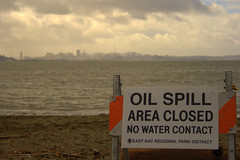 “We’re not antidevelopment. We’re not antigrowth. But this is just stupid.”
“We’re not antidevelopment. We’re not antigrowth. But this is just stupid.”
How many times has that been muttered over the past few years, in an attempt to bring a semblance of common sense to the world?
The answer is, obviously, far too many. But nevertheless it has once again been spoken by Margaret Williams of the World Wildlife Fund in Alaska in response to the leasing of millions of offshore acres for petroleum development in the Chukchi Sea, off Alaska.
At the beginning of the year I reported that the US had blocked “…a landmark assessment of oil and gas activity in the high north polar regions…” thus freeing up room for them to auction off drilling-exploration licenses in the Chukchi Sea.
However, this time it isn’t the wildlife that is presenting the problem – because, who cares about the, right? – but the ability to clean up a possible oil spill – something that isn’t that out of the realm of possibility.
Williams noted that no oil-spill responders have demonstrated the ability to clean up oil in broken ice that ranges from slush to cakes of ice.
Ice is a problem for clean up, because it gets in the way. Consider your normal oil spill; booms, skimmers, pumps, etc. But when you throw a whole heap of ice in to the equation, booms are broken, skimmers are jammed and pumps are clogged.
Add to that the fact that it is night a whole heap of the time, and you have conditions that, Leslie Pearson, the state of Alaska’s director of spill prevention and response, describes as a less than ideal cleanup. “It’s not one of those calls I’d like to wake up to,” she said. “It would put you in a cold sweat.”
In fact, the last time federal and state regulators evaluated an oil spill in icy conditions off Alaska’s coast, the results were less than promising. The results showed that, when ice covered more than 30% of the water, the mechanical recovery system became overwhelmed, and collapsed. In conditions less than 30%, skimmers were able to lift oil from the water, as long as tug boats ran interference for them, removing all but 10% of the ice.
This test, by the way, was conducted by BP Exploration in the Beaufort Sea in 2000.
Of course, the director of the Minerals Management Service Randall Luthi believes otherwise. “It’s my personal belief, and certainly the belief of MMS, that these two are compatible,” Luthi said, “but you’ve got to work at it.”
Oh, isn’t that positively adorable! “It’s my personal belief!”
This coming from the man who was an attorney, rancher and former speaker of the Wyoming House of Representatives; definitely the qualities you want in a man making that statement.
Of course, Luthi isn’t the only one suggesting that things have changed. Ron Morris, general manager of Alaska Clean Seas, an industry cooperative that would respond to a spill in the Beaufort, noted that responders have since added ice management vessels and implemented tactics that included combinations of barge, boat and cranes, so as to remove pockets of oil trapped by ice floes.
Luthi agrees with Morris, saying that “It’s not your traditional boats with booms to trap the oil. That doesn’t work with the ice.” He added that burning is another possibility. But Leslie Pearson reminds us that burning is only an effective option within the first 72 hours; after that, oil emulsifies, and burning and dispersants are dropped from the cleanup equation.
“It takes an oil spill response to another level, as opposed to dealing with an open-water scenario,” she said.
Image courtesy of sara.atkins via Flickr
More from GO
US Censors Arctic Oil and Gas Findings